| [1] Duthon VB, Barea C, Abrassart S, et al. Anatomy of the anterior cruciate ligament. Knee Surg Sports Traumatol Arthrosc. 2006;14(3):204-213. [2] Wu B, Zhao Z, Li S, et al. Preservation of remnant attachment improves graft healing in a rabbit model of anterior cruciate ligament reconstruction. Arthroscopy. 2013;29(8):1362-1371. [3] Song GY, Zhang J, Li X, et al. Biomechanical and Biological Findings Between Acute Anterior Cruciate Ligament Reconstruction With and Without an Augmented Remnant Repair: A Comparative in Vivo Animal Study. Arthroscopy. 2016;32(2):307-319. [4] Zhang L, Qi J, Zeng Y, et al. Proprioceptive Changes in Bilateral Knee Joints Following Unilateral Anterior Cruciate Ligament Injury in Cynomolgus Monkeys. Med Sci Monit. 2018;24:105-113. [5] Andonovski A, Topuzovska S, Samardziski M, et al. The Influence of Anterior Cruciate Ligament Remnant on Postoperative Clinical Results in Patients with Remnant Preserving Anterior Cruciate Ligament Reconstruction. Open Access Maced J Med Sci. 2017;5(5):624-629. [6] Lowe WR, Warth RJ, Davis EP, et al. Functional Bracing After Anterior Cruciate Ligament Reconstruction: A Systematic Review. J Am Acad Orthop Surg. 2017;25(3): 239-249. [7] Kirizuki S, Matsumoto T, Ueha T, et al. The Influence of Ruptured Scar Pattern on the Healing Potential of Anterior Cruciate Ligament Remnant Cells. Am J Sports Med. 2018; 46(6):1382-1388. [8] Naraoka T, Kimura Y, Tsuda E, et al. Is Remnant Preservation Truly Beneficial to Anterior Cruciate Ligament Reconstruction Healing? Clinical and Magnetic Resonance Imaging Evaluations of Remnant-Preserved Reconstruction. Am J Sports Med. 2017;45(5):1049-1058. [9] 宋关阳.有关膝关节保留残端前交叉韧带重建的相关研究[D]. 北京:清华大学,2016.[10] 于长隆,曲绵域.实用运动医学[M].北京:北京大学医学出版社, 2003:482-483.[11] Wirth B, Liffert F, de Bruin ED. Development and evaluation of a German version of the Lysholm score for measuring outcome after anterior cruciate ligament injuries. Sportverletz Sportschaden. 2011;25(1):37-43. [12] Hefti F, Müller W, Jakob RP, et al. Evaluation of knee ligament injuries with the IKDC form. Knee Surg Sports Traumatol Arthrosc. 1993;1(3-4):226-234. [13] 黄萍,钱念东,齐进,等.膝骨关节炎患者膝关节置换术后足底压力研究[J].中国运动医学杂志,2018,37(3):197-201[14] Bastin J, Calvin S, Montagne G. Muscular proprioception contributes to the control of interceptive actions. J Exp Psychol Hum Percept Perform. 2006;32(4):964-972. [15] Dhillon MS, Bali K, Prabhakar S. Proprioception in anterior cruciate ligament deficient knees and its relevance in anterior cruciate ligament reconstruction. Indian J Orthop. 2011;45(4): 294-300. [16] 陈均源,王华军,罗斯敏,等.前交叉韧带重建本体感觉恢复影响因素分析[J].中国矫形外科杂志,2016,24(24):2264-2268.[17] Kim HJ, Lee JH, Lee DH. Proprioception in Patients With Anterior Cruciate Ligament Tears: A Meta-analysis Comparing Injured and Uninjured Limbs. Am J Sports Med. 2017;45(12): 2916-2922. [18] Dhillon MS, Bali K, Vasistha RK. Immunohistological evaluation of proprioceptive potential of the residual stump of injured anterior cruciate ligaments (ACL). Int Orthop. 2010; 34(5):737-741. [19] Bali K, Dhillon MS, Vasistha RK, et al. Efficacy of immunohistological methods in detecting functionally viable mechanoreceptors in the remnant stumps of injured anterior cruciate ligaments and its clinical importance. Knee Surg Sports Traumatol Arthrosc. 2012;20(1):75-80. [20] Riemann BL, Lephart SM. The Sensorimotor System, Part II: The Role of Proprioception in Motor Control and Functional Joint Stability. J Athl Train. 2002;37(1):80-84. [21] Lee BI, Min KD, Choi HS, et al. Immunohistochemical study of mechanoreceptors in the tibial remnant of the ruptured anterior cruciate ligament in human knees. Knee Surg Sports Traumatol Arthrosc. 2009;17(9):1095-1101. [22] Kosy JD, Mandalia VI. Anterior Cruciate Ligament Mechanoreceptors and their Potential Importance in Remnant-Preserving Reconstruction: A Review of Basic Science and Clinical Findings. J Knee Surg. 2018;31(8): 736-746. [23] Ahn JH, Wang JH, Lee YS, et al. Anterior cruciate ligament reconstruction using remnant preservation and a femoral tensioning technique: clinical and magnetic resonance imaging results. Arthroscopy. 2011;27(8):1079-1089. [24] Crain EH, Fithian DC, Paxton EW, et al. Variation in anterior cruciate ligament scar pattern: does the scar pattern affect anterior laxity in anterior cruciate ligament-deficient knees? Arthroscopy. 2005;21(1):19-24. [25] Muneta T, Koga H. Anterior cruciate ligament remnant and its values for preservation. Asia Pac J Sports Med Arthrosc Rehabil Technol. 2016;7:1-9. [26] Zhang S, Matsumoto T, Uefuji A, et al. Anterior cruciate ligament remnant tissue harvested within 3-months after injury predicts higher healing potential. BMC Musculoskelet Disord. 2015;16:390. [27] Angoules AG, Mavrogenis AF, Dimitriou R, et al. Knee proprioception following ACL reconstruction; a prospective trial comparing hamstrings with bone-patellar tendon-bone autograft. Knee. 2011;18(2):76-82. [28] Furlanetto TS, Peyré-Tartaruga LA, do Pinho AS, et al. Proprioception, body balance and functionality in individuals with acl reconstruction. Acta Ortop Bras. 2016;24(2):67-72.[29] Gohil S, Annear PO, Breidahl W. Anterior cruciate ligament reconstruction using autologous double hamstrings: a comparison of standard versus minimal debridement techniques using MRI to assess revascularisation. A randomised prospective study with a one-year follow-up. J Bone Joint Surg Br. 2007;89(9):1165-1171. [30] Ahn JH, Lee SH, Choi SH, et al. Magnetic resonance imaging evaluation of anterior cruciate ligament reconstruction using quadrupled hamstring tendon autografts: comparison of remnant bundle preservation and standard technique. Am J Sports Med. 2010;38(9):1768-1777. [31] Li B, Wang GB, Wang YF, et al. Effects of pre-operative knee laxity on clinical outcomes after partial anterior cruciate ligament reconstruction. Knee. 2018;25(3):445-452. [32] An KO, Park GD, Lee JC. Effects of acceleration training 24 weeks after anterior cruciate ligament reconstruction on proprioceptive and dynamic balancing functions. J Phys Ther Sci. 2015;27(9):2825-2828. [33] Park JH, Jeong WK, Lee JH, et al. Postural stability in patients with anterior cruciate ligament tears with and without medial meniscus tears. Knee Surg Sports Traumatol Arthrosc. 2015; 23(1):240-245. [34] Nakamae A, Ochi M, Deie M, et al. Biomechanical function of anterior cruciate ligament remnants: how long do they contribute to knee stability after injury in patients with complete tears? Arthroscopy. 2010;26(12):1577-1585. [35] Takahashi T, Kondo E, Yasuda K, et al. Effects of Remnant Tissue Preservation on the Tendon Graft in Anterior Cruciate Ligament Reconstruction: A Biomechanical and Histological Study. Am J Sports Med. 2016;44(7):1708-1716. [36] Tie K, Chen L, Hu D, et al. The difference in clinical outcome of single-bundle anterior cruciate ligament reconstructions with and without remnant preservation: A meta-analysis. Knee. 2016;23(4):566-574. [37] 许锦煌,黄建荣,尹萍,等.保留残端对前交叉韧带重建术后恢复的临床意义[J].中国临床解剖学杂志,2015,33(5):584-587.[38] Lee BI, Kwon SW, Kim JB, et al. Comparison of clinical results according to amount of preserved remnant in arthroscopic anterior cruciate ligament reconstruction using quadrupled hamstring graft. Arthroscopy. 2008;24(5):560-568. [39] Hexter AT, Thangarajah T, Blunn G, et al. Biological augmentation of graft healing in anterior cruciate ligament reconstruction. Bone Joint J. 2018;100-B(3):271-284. [40] Lee BI, Min KD, Choi HS, et al. Arthroscopic anterior cruciate ligament reconstruction with the tibial-remnant preserving technique using a hamstring graft. Arthroscopy. 2006;22(3): 340. e1-7. [41] Weninger P, Wepner F, Kissler F, et al. Anatomic Double-Bundle Reinsertion After Acute Proximal Anterior Cruciate Ligament Injury Using Knotless PushLock Anchors. Arthrosc Tech. 2015;4(1):e1-6. |
.jpg)
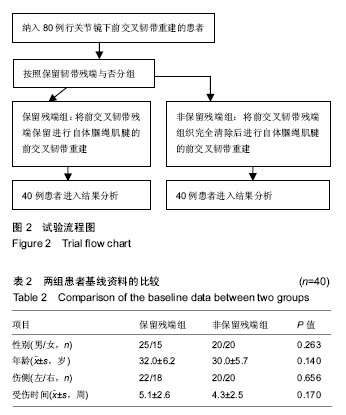
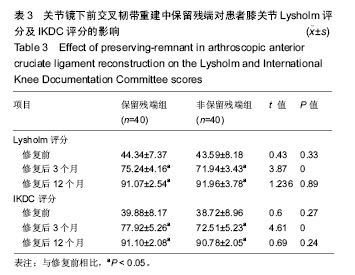
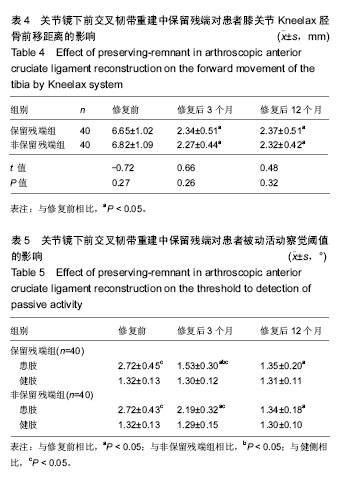
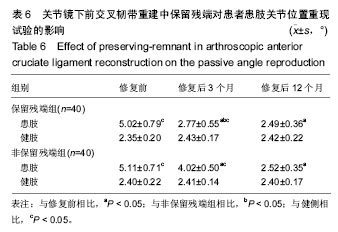
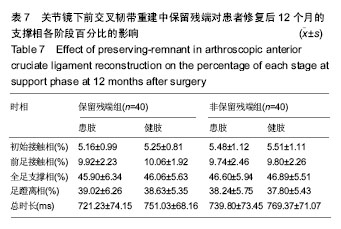
.jpg)
.jpg)
.jpg)